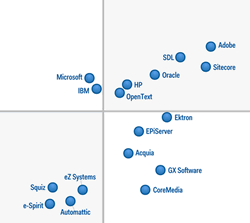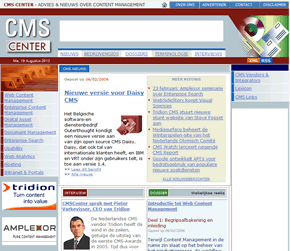
Content management became popular at the beginning of the new millennium. This was among others due to a specific form of content management: web content management. At the same time, the need for a better management of and access to content, that was shattered within the organizations and wasn’t managed across the information lifecycle, gave birth to Enterprise Content Management (ECM).
The goal was the same as in information management: the right information/content to the right people in the right context at the right time.
In the age of social, mobile and content marketing, web content management is changing. However, most of all, these changes are about the customer (experience) and an integrated digital business approach.
A bit of history. One of the main challenges organizations were confronted with at the beginning of the online (and digital) age was efficiently managing the masses of digital documents they started having: from invoices, marketing collateral and images to website content and scanned documents for vertical use (e.g. medical imaging).
Managing all this content, content management, was around before the Web started being used for business and marketing goals. Yet, web content management really opened up a new world of opportunities and rapidly became a booming industry (for reasons of efficiency, speed, independence and much more).
Several of those early-day web content management players today still exist, be it often integrated with other applications. The industry, just as other software industries, went through a period of consolidation, partnerships and change (e.g. SDL and Tridion, a former customer) among others driven by new digital technologies and the almost natural connections between different platforms for the WWW.
Nevertheless, content management essentially still is about capturing/creating documents and content in digital formats, storing them in an efficient way so they can easily be found and retrieved, and presenting them across various channels and formats where and when needed. In a digital marketing context the latter involves channels such as the website. But things are evolving fast.
Content management: some background and evolutions
Content management is a broad term, involving many processes and tasks on top of the above mentioned and with several subdomains:
- Workflows and content-related processes: planning, versioning, distribution, etc.
- Archiving and searching (enterprise search and web search).
- Web Content Management, Enterprise Content Management (ECM), Document Management, Knowledge Management, etc.
The increasing attention for multi-channel marketing, integrated digital business, content marketing, social media marketing and social business, mobile evolutions, collaboration, etc. are among many reasons why enterprise content management and intranets (social business…) are becoming ‘hot’ again, why web content management systems (WCMS) start attracting more attention from business execs and why even the sales of document management and capturing services/solutions/hardware are up.
Without a profound understanding of the essentials of content management and the content life cycle, it’s virtually impossible to have a holistic view of the success factors of content for business and for marketing, the context in which it’s predominantly used in this ‘content marketing’ age. As a matter of fact, there is a strong link between the content management life cycle model and the content marketing strategy model. And both are steered by customer experience optimization and the customer life cycle across all touches with customers in the broadest sense.
Depending on the types of content and their usage context, many new solutions hit the market that in a sense involve content management, on top of web content management systems.
- Marketing Resource Management software (MRM) has a component of (marketing) content and collateral.
- Content marketing software and the different types of content marketing platforms, often have a content management aspect.
- Marketing automation platforms in many cases have a content management dimension.
- Collaboration and social business software is in reality very often about content and information, be it with a very strong collaboration focus.
- The list goes on.
Content management, collaboration and customers: it’s all about experiences
If you’re interested in content marketing or digital business in general, you can’t hide from technology and processes. It’s my firm belief all today’s marketers (and execs) should “get” the value of the technologies their business and customers use, understand where technology fits in the overall business context and know what pieces matter to achieve business goals and provide great customer experiences. You can’t put content marketing in a silo nor can you put content in a marketing silo as it’s about much more than that.
Two other reasons have everything to do with your customers and your internal processes and performance:

Many years ago we had a website on content management (mainly web content management), called CMSCenter, and published a yearly content management book (with a partner). Here are two tips/reasons/quotes that remain very relevant.
- A (web) content management system should provide website visitors with information in a fast, clear, adapted and friendly way, which increases the user experience and the website’s efficiency. But also the customer experience matters, as do integration capabilities and this is where there is a lot of work to do.
- Another quote that is still relevant (translated): the quality of information and content on a website is vital for the overall experience. Redundant information and content that is not updated when it should, leads to poor conversions and experiences. At the same time a consistent ‘house style’ and brand experience is important. The management and publishing of content from a distributed or non-distributed and more centralized approach is important here as well: consistent brand experiences and ongoing optimization matter a lot.
Digital marketing, content marketing, social business, customer service, engagement, etc.: it’s always about the customer experience and value in a consistent and connected/optimized way. It’s not a coincidence web content management vendors decreasingly speak about web content management and increasingly about multichannel customer engagement or digital engagement/experience platforms. And it’s not a coiincidence solutions from the ECM/intranet background are increasingly looking at social business and collaboration.
In a real-time and connected economy where consistent customer experiences using content in a smart way, all these reasons are more essential than ever.

